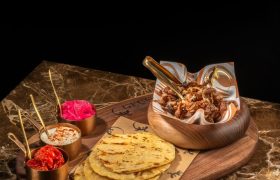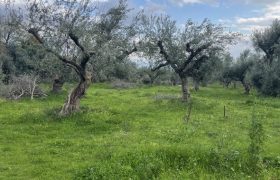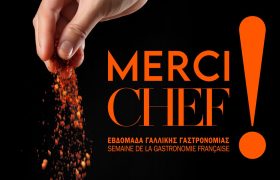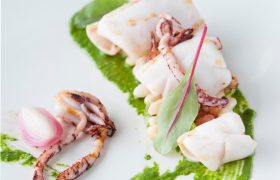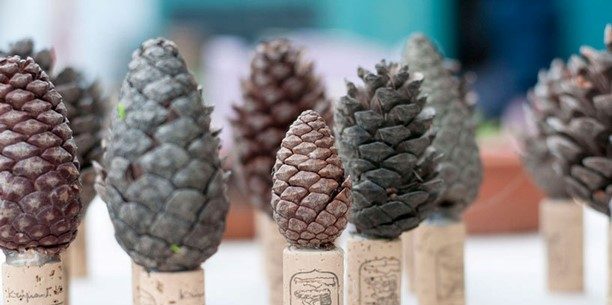Two Classic Greek Christmas Sweets
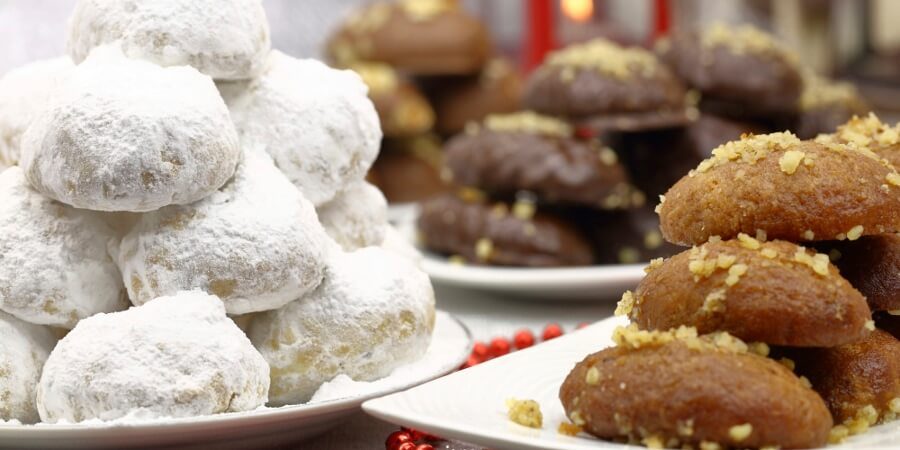
Greek Christmas Sweets
It’s not Christmas in Greece until the zacharoplasteia start piling mounds of melomakarona and kourabiedes. And it cleaves Greek society into two clans: those who prefer the crunchy intensity of melomakarona and those who swear by the ethereal, melt in the mouth, buttery bite of a kourabie. By Diana Farr Louis
More traditional than Santa Claus or the Christmas tree, two scrumptious biscuits are indispensable additions to the Greek holiday table. Platters piled high with nutty brown melomakarona and snow white kourabiedes form part of the festive fare of virtually every Greek household, ready to be offered to any guest who happens by, invited or not. Or nibbled by family members at any time of day.
You might also find honey-sprinkled diples (sheets or coils of feather-light fried pastry), silver-wrapped marrons glacés, and mountains of clementines for color, but melomakarona and kourabiedes are the main attractions, the yang and yin of Christmas delicacies. Not surprisingly, they also have fans, similar to football teams. My husband prefers the crunchy intensity of melomakarona, while I find them too sweet and can become ecstatic over an ethereal, melt in the mouth, buttery bite of a kourabie.
Both sweets have long and improbable histories that are tied up with their etymology.
Kourabiedes, which are essentially shortbread, may consist of nothing more than butter, flour, and sugar. The version we are most likely to find on the Christmas table is enriched with the addition of crushed almonds, brandy, and eggs, and covered with a thick dusting of confectioner’s sugar. But some recipes call for crushed walnuts, cinnamon or vanilla, orange blossom or rose water, and even olive oil instead of butter (which would make them acceptable to observant Orthodox who fast before Christmas). Every recipe agrees however that the cookies, whether round, flat, crescents, leaf-shaped, or bracelets, should be baked until they are barely coloured. Whiteness is essential, even if a slight ‘tan’ can be concealed by the powdered sugar, which usually ends up powdering your chin, nose and clothes. The white is considered symbolic of good fortune and happiness.
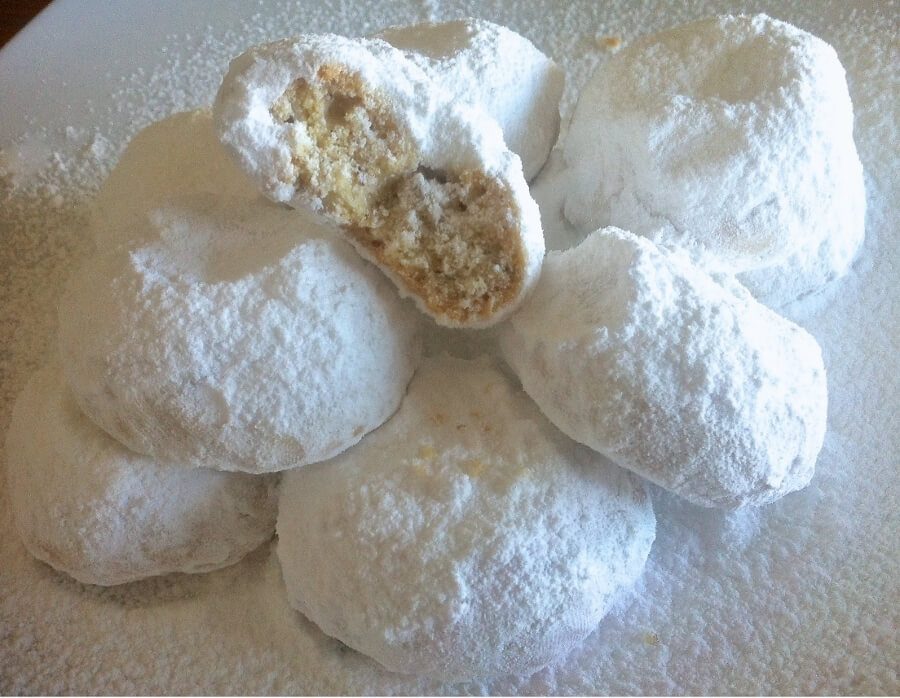
Kourampies
But what about the name? A little research brings up a tangle of sometimes conflicting information, for this sweet is found all over the Middle East and the Balkans and thought to originate from Tabriz, Iran. Some sources say that Gurabiah (also Ghraybeh or Ghorayebah), as they are called in Arabic, comes from the word “gharib”, which means “to miss or yearn for”, or even “to swoon,” so that they are often heart-shaped and referred to as “Lovers’ shortbread.” Others say that the Turkish “kurabiye” comes from two words meaning “dry” and “biscuit.” Both sound valid.
One thing all versions have in common is that they are offered as favours during weddings and christenings and served at holidays, whether the end of Ramadan or Christmas. They may be flavoured with cardamom, as was the fashion in Jewish communities in Iraq, pistachios as in Gaziantep, where almost every sweet contains the green nut, or even covered with gold leaf for the delectation of the Ottoman sultan’s court (and some very wealthy Turkish families even today). But they always have a festive connotation.
The same cannot be said for melomakarona, which have a coarser texture and are always made with olive oil, flavored with spices, orange juice and brandy, and sprinkled with chopped walnuts. In fact, they seem to be derived from a very ancient, Greek custom associated not with joy and renewal but with death and funerals.
Andrew Dalby, the noted food historian, says that Makaria (also the name of the goddess of blessed death, variously described as a daughter of Hercules or of Hades), was the meal, the dinner of the dead, served after a funeral in ancient Greece. Small oval breads, perhaps the forerunners of melomakarona and shaped like them, were also eaten then. As you may surmise, “makaron”, whose root means a doughy substance, found its way to a much more common food, macaroni or pasta, too.
Nowadays, with the prefix “melo” meaning “honey”, these biscuits, which are often dipped in honey syrup, have lost all connotation of mourning and sadness and rightfully claim their place at the festive table.
Nevertheless, anyone fluent in Greek would know that “makaritis” is a term that means “beloved departed” and that “kourabies” is slang for a coward or fraidy-cat.
What’s in a name? These cookies by any other names would taste as sweet, but maybe knowing more about their origins will add to the pleasure of that first bite. And why enjoy them only during the holidays? Bakeries stock them all year round now.
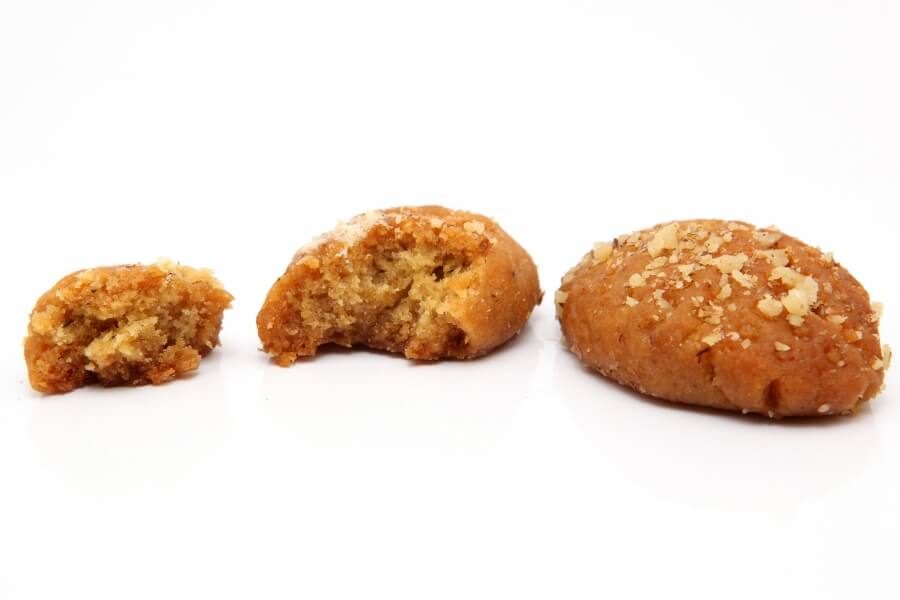
Melomakarona
But if you’d like to make your own, I offer this recipe for melomakarona from my book Feasting and Fasting in Crete. Kourabiedes, being more delicate and often calling for clarified butter, are harder to get right. These are actually the only melomakarona I like, since the cookies are stuffed with walnuts rather than merely sprinkled with them, and because they are utterly delicious without syrup, which I find cloying.
For the dough
- about 450 grams (3-4 cups) all purpose flour
- 1/2 teaspoon baking powder
- 240 ml (1 cup) olive oil
- 50 grams (1/4 cup) sugar
- 1/2 teaspoon baking soda diluted in
- 120 ml (1/2 cup) fresh orange juice
- 60 ml (1/4 cup) brandy
- grated peel of one lemon
Sift the flour with the baking powder into a bowl.
In a larger bowl beat together the olive oil and sugar with the electric mixer for 3 or 4 minutes and then beat in the other liquids adding the grated lemon peel at the end. Slowly stir in the flour until a soft dough forms. Remove the dough from the bowl and knead it on a lightly floured surface until it is smooth and malleable. Add more flour if the dough seems sticky. Cover with cling film and set aside to rest for about 30 minutes.
Walnut filling
- 1/2 kg (1 lb) walnuts, coarsely chopped
- 3 heaping tablespoons honey
- 1 tablespoon cinnamon
- 1/4 teaspoon ground cloves
- 1/4 teaspoon grated nutmeg
Mix all these ingredients together with your hands or a wooden spoon to distribute the spices evenly.
Preheat the oven to 180°C (350°F).
Pinch off a walnut sized piece of dough and roll it into a ball. Make a hole in it with your thumb and fill it with some of the walnut mixture. Close the hole and place the ball, which should look like a small egg, onto an ungreased cookie sheet. When all the dough has been shaped into biscuits, bake for about 30 minutes or until golden.
Syrup (optional)
- 150 grams (3/4 cup) sugar
- 120 ml (1/2 cup) honey
- 120 ml (1/2 cup) water
- 60 ml (1/4 cup) brandy
Boil these ingredients together for 3 minutes, skimming off the foam. Dip the biscuits in the syrup when it has thoroughly cooled or the next day. Sprinkle finely ground walnuts and roasted sesame seeds on top. Makes about 2-3 dozen, depending on how large you want them.

